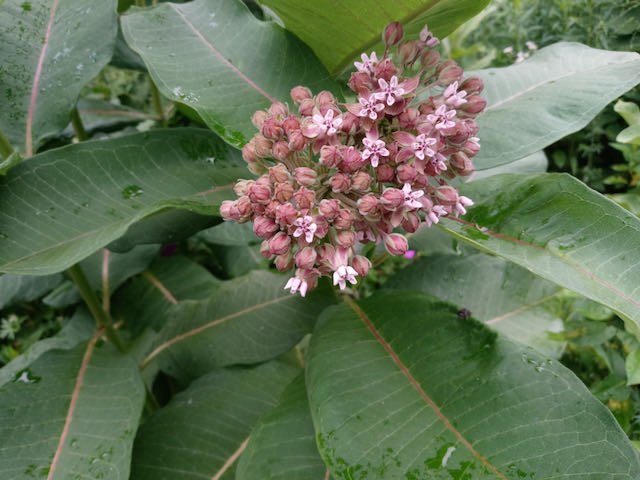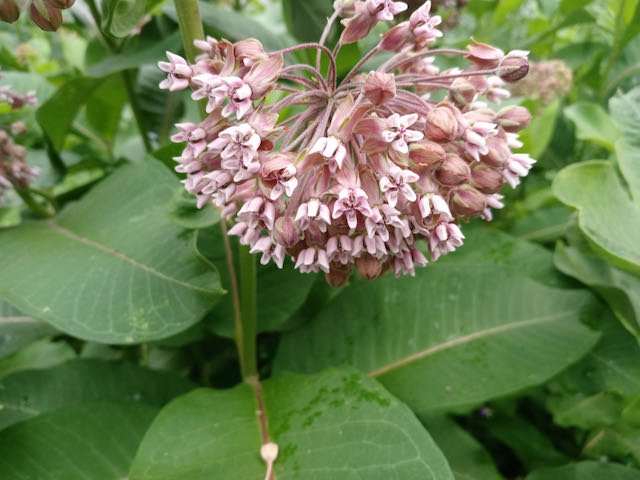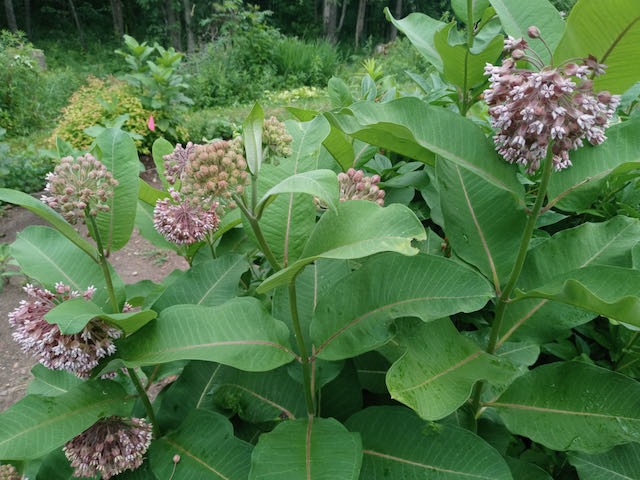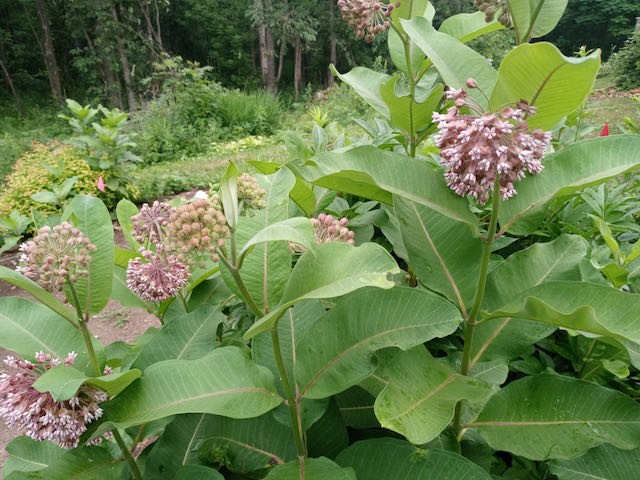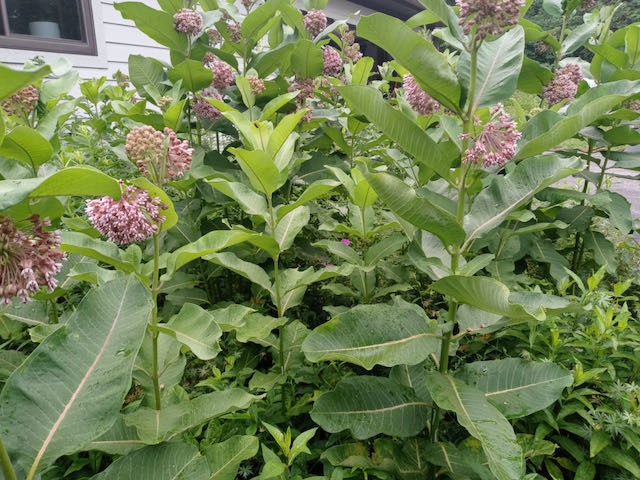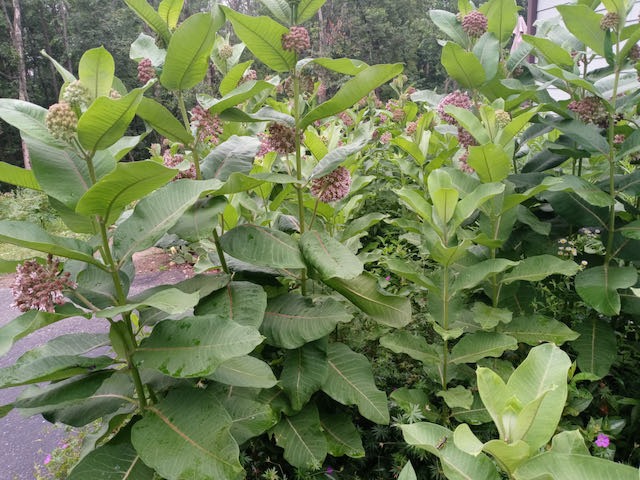common milkweed
Asclepias syriaca
Description:
Well known a half century ago as an abundant roadside weed, common milkweed was extensively controlled by farmers and road crews across Wisconsin. The success of the weed management efforts caused a dramatic decline in the number of monarch butterflies that require milkweed plants milkweed plants as a place to lay their eggs and to nourish monarch caterpillars as they develop.
A recent scientific review recommended that the monarch butterfly be added to the federal Endangered Species list. That recommendation was rejected because there were not sufficient resources to enforce its protection under the law. Voluntary efforts are underway to increase milkweed numbers to protect and restore monarch butterfly populations.
Common milkweed is the largest and most abundant species of milkweed in Wisconsin. Other species include: butterfly milkweed, clasping milkweed, green-flowered milkweed, marsh (swamp) milkweed, poke milkweed, prairie milkweed, purple milkweed, wooly milkweed, and whorled milkweed.
Details:
common milkweed
| USDA Symbol: | Common Name: | Scientific Name: |
|---|---|---|
| ASSY | common milkweed | Asclepias syriaca |
ITIS TSN: 30310
Category: Dicot
Taxonomy
Kingdom: Plantae
Subkingdom:
Super Division: Spermatophyta
Division: Magnoliophyta
Subdivision:
Class: Magnoliopsida
SubClass: Asteridae
Order: Gentianales
Family: Asclepiadaceae
Counties: Adams, Ashland, Barron, Bayfield, Brown, Buffalo, Burnett, Calumet, Chippewa, Clark, Columbia, Crawford, Dane, Dodge, Door, Douglas, Dunn, Eau Claire, Florence, Fond du Lac, Forest, Grant, Green, Green Lake, Iowa, Iron, Jackson, Jefferson, Juneau, Kenosha, Kewaunee, La Crosse, Lafayette, Langlade, Lincoln, Manitowoc, Marathon, Marinette, Marquette, Milwaukee, Monroe, Oconto, Oneida, Outagamie, Ozaukee, Pepin, Pierce, Polk, Portage, Price, Racine, Richland, Rock, Rusk, Sauk, Sawyer, Shawano, Sheboygan, St. Croix, Taylor, Trempealeau, Vernon, Vilas, Walworth, Washburn, Washington, Waukesha, Waupaca, Waushara, Winnebago, Wood
| Duration: | Growth Habit: | Native Status: |
|---|---|---|
| Perennial | Forb/herb | L48(N)CAN(N) |
Carbon to Nitrogen Ratio:
Conspicuous Fall Color: No
Flower Color: Purple, White, Pink
Conspicuous Flower: Yes
Foliage Color: Dark Green
Foliage Light Porosity Summer:
Growth Form: Rhizomatous
Height at Base Age (Max):
Known Alelopath: No
Leaf Retention: No
Re-sproutability:
Shape and Orientation: Erect
Toxicity: Moderate
Height (min): 36
Height (max): 72
Leaf Type: simple
Leaf Arrangement: opposite
Leaf Shape: lanceolate, oblong, ovate, eliptic
Leaf Margin: entire
Vein Pattern:
Adapted to Coarse Textured Soils:
Adapted to Medium Textured Soils:
Adapted to Fine Textured Soils:
Moisture Use: Low, Medium, High
pH (Minimum): 4.8
pH (Maximum): 6.8
Planting Density per Acre, Minimum:
Planting Density per Acre, Maximum:
Precipitation (Minimum):
Precipitation (Maximum):
Root Depth, Minimum (inches):
Shade Tolerance: Intolerant
Plant Spacing (min): 12
Plant Spacing (max): 12
| Bloom Period: | Commercial Availability: | Fruit/Seed Abundance: |
|---|---|---|
| Late Spring, Early Summer | Routinely Available | Medium |
| Fruit/Seed Period Begin: | Fruit/Seed Period End: | Fruit/Seed Persistence: |
|---|---|---|
| Fall | Fall | No |
| Propogated by Bare Root: | Propogated by Bulbs: | Propogated by Container: |
|---|---|---|
| Yes | No | Yes |
| Propogated by Corms: | Propogated by Cuttings: | Propogated by Seed: |
|---|---|---|
| No | Yes | Yes |
| Propogated by Sod: | Propogated by Sprigs: | Propogated by Tubers: |
|---|---|---|
| No | No | No |
| Seeds per Pound: | Seed Spread Rate: | Seedling Vigor: |
|---|---|---|
| 64000 | Moderate | High |
| Small Grain: | Vegetative Spread Rate: | Propagation Treatment: |
|---|---|---|
| No | Moderate |
| Days to Stratify: | Direct Sowing Time: |
|---|---|
| 10 | Spring, Early Summer, Fall |
Benefits: Butterflies, Host Plant, Pollinators
| Berry/Nut/Seed Product: | Christmas Tree Product: | Fodder Product: |
|---|---|---|
| No | No | No |
| Fuelwood Product: | Lumber Product: | Naval Store Product: |
|---|---|---|
| No | No | No |
| Nursery Stock Product: | Palatable Browse Animal: | Palatable Graze Animal: |
|---|---|---|
| Yes | -- | Low |
| Palatable Human: | Post Product: | Protein Potential: |
|---|---|---|
| No | -- | -- |
| Pulpwood Product: | Veneer Product: |
|---|---|
| No | No |
| Benefits: | Wildlife Food Value: | Wildlife Cover Value: |
|---|---|---|
| Butterflies, Host Plant, Pollinators | Low | Low |

